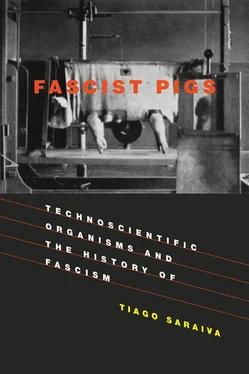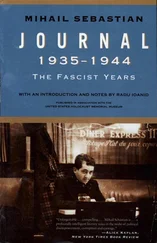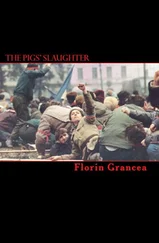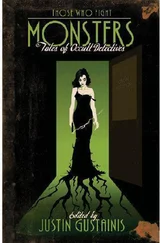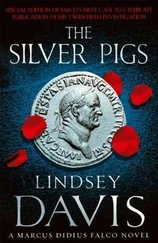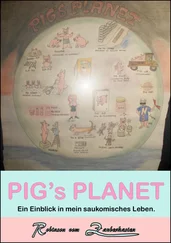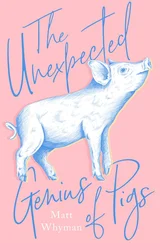In thinking about science and fascism it is worth considering how, in the last few decades, the historiographical status of fascism has changed from a temporal hiatus in which irrationality reigned into an integral part of the human experience with modernity. [21]Roger Griffin is the author who has most consistently argued for the need to perceive fascism as a modernist political ideology promising to counter the unsettling effects of modernization in which, as Marx put it, “all that is solid melts into the air.” [22]Taking fascist talk seriously, as Griffin does, makes it possible to identify a coherent political project of national rebirth promising a sense of transcendence and purpose to societies allegedly under the modern menaces of individualism, social anomy, alienation, and instability. [23]Breaking with the past, manufacturing new historical traditions, and imagining alternative futures were not gestures limited to the modernist artistic avant-garde. [24]Fascists also deserve to be counted among the modernists due to their radical and revolutionary commitment to national renewal, aimed at countervailing the acute sense of crisis of interwar Europe. [25]Whereas Mussolini insisted that “all the political experiments of the contemporary world are anti-Liberal,” Salazar, having considered “the great laboratory of the world today” (that is, in 1934), predicted “within twenty years, if there is not some retrograde movement in political evolution, there will be no legislative assemblies left in Europe.” [26]
In this view of fascism as modernism, fascism is much more than a radicalized version of old-fashioned conservatism; it is an all-encompassing modernist social experiment with the purpose of inventing a new national community. Fascists were not reactionaries struggling to freeze history; they were radical experimenters in political conformations. The past certainly played a role, but it was a new, streamlined past invented by the propagandists of the different regimes. Roman legionaries, Teutonic knights, and Portuguese sailors of the Age of Discovery were brought to life in exhibitions, radio broadcasts, and films. [27]But no one thought of actually adopting their lifestyles; they served as modern myths binding the collective together. Mass cultural rituals, eugenic measures, urban planning, welfare policies, censorship, transportation networks, and military power were all elements of the modernist experimental gesture of forming a new national community, an alternative modernity to Bolshevism and liberal democracy.
It is hard to avoid discomfort when applying the notion of “alternative modernity” to fascism—all the more so when considering that many of those who use that term do it with emancipatory intentions, highlighting the multiple forms modernity may assume in the global South, beyond the Western versions of modernization theory. [28]Nevertheless, as S. N. Eisenstadt has convincingly shown when discussing the modern features of current religious fundamentalism, there is no necessary goodness attached to “alternative modernity” (he actually prefers “multiple modernities”). [29]There is also no goodness in a fascist alternative modernity and its totalistic attempt of transforming man and society—an attempt in which the authority of the dictator replaced political democracy and those who because of race or politics were not considered to belong to the national community were deprived of citizenship and eventually eliminated.
But if we take this notion of fascism as alternative modernity as valid, as I think we should, the role of historians of science and technology in producing a better understanding of the phenomenon becomes clearer. Their engagement with the “detail, ambiguity, and variety” of practices and objects of scientists and engineers may contribute decisively to overcoming the limits of accounts of modernity based on naive notions of how science and technology interact with society. [30]In fact, Michael Thad Allen and Thomas Zeller have already demonstrated the advantages of looking in depth at technology when describing the particular version of modernity associated with Nazis. Whereas Allen, focusing on labor management techniques, replaced Hannah Arendt’s figure of the perpetrator of genocide as a personification of the banality of evil with the SS member as a modernist bureaucrat driven by his enthusiasm for efficiency and racial utopian visions, Zeller detailed the contested process of making Hitler’s Autobahnen fit the larger project of shaping a “Volk community that claimed to equalize social differences, smooth out distinctions of class and estate, and be racially homogeneous.” [31]In both cases, the old paradox of reactionary modernism that suggested an unsolved problematic contradiction at the heart of Nazi ideology between romanticism and technical rationality gave way to an image of technologies embodying fascist alternative modernity. [32]More recently, Lino Camprubí has made an important addition to this literature by looking at the co-evolution of engineering and the Francoist regime and showing how typical fascist notions of Spanish national redemption were embodied in technological undertakings. [33]Moreover, such approaches resonate nicely with the important trend in history of science of overcoming the traditional opposition between romanticism and scientific knowledge, a trend that emphasizes how machines were historically able to materialize romantic social utopias, or (to stick to the vocabulary) how scientific instruments and technology embodied romantic alternative modernity. [34]In the same vein, this book delves into the alternative fascist world that science produced, not the alternative science that fascism produced.
Food and the Fascist Organic Nation
Feeding the organic nation played a decisive role in fascist alternative modernity. For fascists, the nation deserved all sacrifices and made allegiances to class or ideology irrelevant. [35]Social and cultural historians have detailed how imagined national communities came into being in the nineteenth century through the invention of a national culture and its dissemination in classrooms, in the press, in world exhibitions, or in army barracks. [36]Building on the different local nationalistic ideologies thus formed, fascists all across Europe developed a radicalized integral form of nationalism by adhering to a biological conception of the nation as organ, body, or race. [37]Liberal regimes were accused of failing in their duties toward the nation and of having led it to the verge of extinction in World War I. Once the conflict ended, veterans were quick to call for a constant mobilization to defend this menaced national body, eliminating the traditional distinctions between reserve and action and between peace and war. [38]And if not every fascist regime put as much emphasis as the Nazis did on the dangerous intrusion of inferior races, none ignored the alleged menace of food scarcity. Hunger, experienced throughout Europe during World War I, made plausible depictions of the nation through the figure of the endangered body. [39]As Nazi propaganda emphatically put it, Germans were “the children of the potato,” having had their existence menaced in World War I as much by the epidemics of late blight that afflicted the potato crop as by enemy weapons. [40]
Though questions of race have traditionally contributed to establishing differences between fascist regimes, with Germany as an outlier, food points instead at the many commonalities of fascist experiences. In other words, in fascist studies food is a lumper whereas race is a splitter. [41]This is important for the present book, since the narrative not only makes comparisons between the three countries but also insists on the importance of following concrete trans-national historical dynamics connecting the three fascist regimes under study.
Читать дальше
